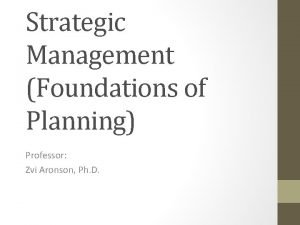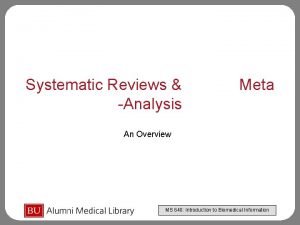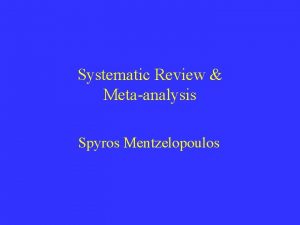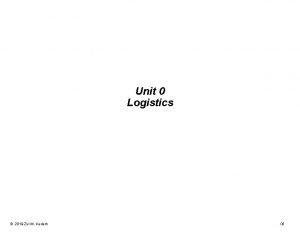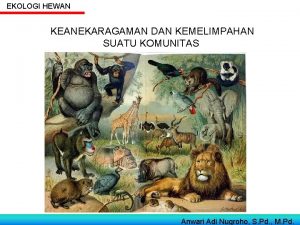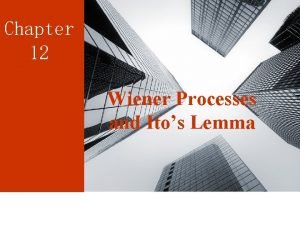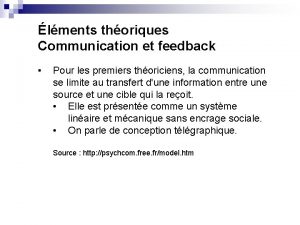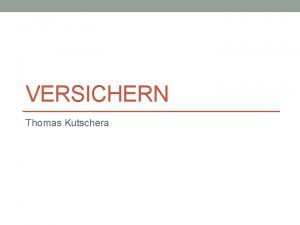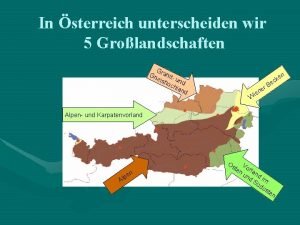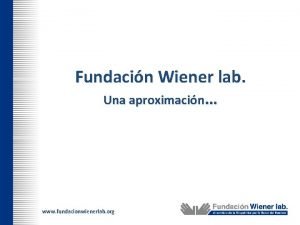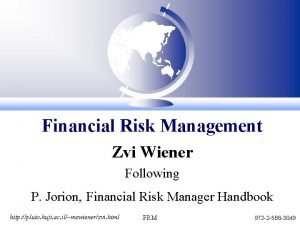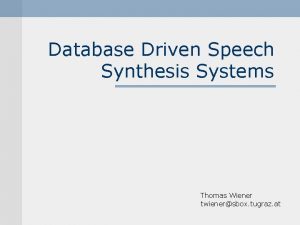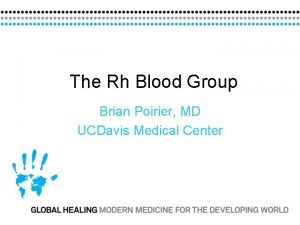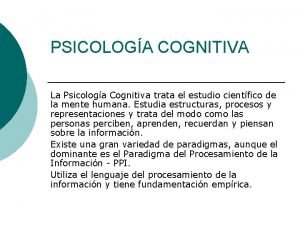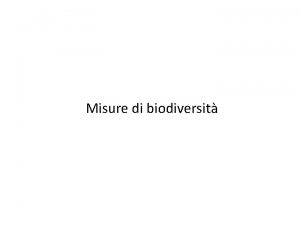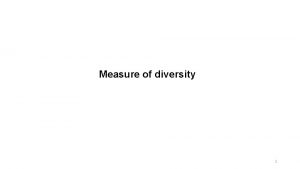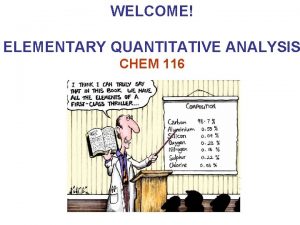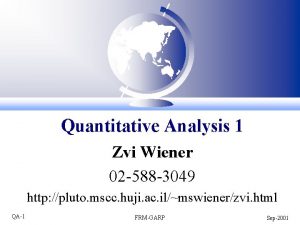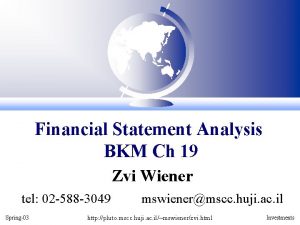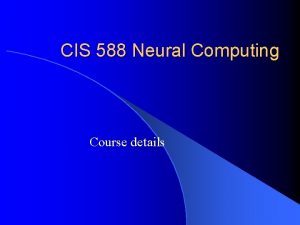Quantitative Analysis 2 Zvi Wiener 02 588 3049











































- Slides: 43

Quantitative Analysis 2 Zvi Wiener 02 -588 -3049 http: //pluto. mscc. huji. ac. il/~mswiener/zvi. html QA-2 FRM-GARP Sep-2001

Fundamentals of Probability Following Jorion 2001 QA-2 FRM-GARP Sep-2001

Random Variables Values, probabilities. Distribution function, cumulative probability. Example: a die with 6 faces. http: //www. tfii. org Zvi Wiener - QA 2 3

Random Variables Distribution function of a random variable X F(x) = P(X x) - the probability of x or less. If X is discrete then If X is continuous then Note that http: //www. tfii. org Zvi Wiener - QA 2 4

Random Variables Probability density function of a random variable X has the following properties http: //www. tfii. org Zvi Wiener - QA 2 5

Multivariate Distribution Functions Joint distribution function Joint density - f 12(u 1, u 2) http: //www. tfii. org Zvi Wiener - QA 2 6

Independent variables Credit exposure in a swap depends on two random variables: default and exposure. If the two variables are independent one can construct the distribution of the credit loss easily. http: //www. tfii. org Zvi Wiener - QA 2 7

Conditioning Marginal density Conditional density http: //www. tfii. org Zvi Wiener - QA 2 8

Moments Mean = Average = Expected value Variance http: //www. tfii. org Zvi Wiener - QA 2 9

Its meaning. . . Skewness (non-symmetry) Kurtosis (fat tails) http: //www. tfii. org Zvi Wiener - QA 2 10

Main properties http: //www. tfii. org Zvi Wiener - QA 2 11

Portfolio of Random Variables http: //www. tfii. org Zvi Wiener - QA 2 12

Portfolio of Random Variables http: //www. tfii. org Zvi Wiener - QA 2 13

Product of Random Variables Credit loss derives from the product of the probability of default and the loss given default. When X 1 and X 2 are independent http: //www. tfii. org Zvi Wiener - QA 2 14

Transformation of Random Variables Consider a zero coupon bond If r=6% and T=10 years, V = $55. 84, we wish to estimate the probability that the bond price falls below $50. This corresponds to the yield 7. 178%. http: //www. tfii. org Zvi Wiener - QA 2 15

Example The probability of this event can be derived from the distribution of yields. Assume that yields change are normally distributed with mean zero and volatility 0. 8%. Then the probability of this change is 7. 06% http: //www. tfii. org Zvi Wiener - QA 2 16

Quantile (loss/profit x with probability c) 50% quantile is called median Very useful in Va. R definition. http: //www. tfii. org Zvi Wiener - QA 2 17

FRM-99, Question 11 X and Y are random variables each of which follows a standard normal distribution with cov(X, Y)=0. 4. What is the variance of (5 X+2 Y)? A. 11. 0 B. 29. 0 C. 29. 4 D. 37. 0 http: //www. tfii. org Zvi Wiener - QA 2 18

FRM-99, Question 11 http: //www. tfii. org Zvi Wiener - QA 2 19

FRM-99, Question 21 The covariance between A and B is 5. The correlation between A and B is 0. 5. If the variance of A is 12, what is the variance of B? A. 10. 00 B. 2. 89 C. 8. 33 D. 14. 40 http: //www. tfii. org Zvi Wiener - QA 2 20

FRM-99, Question 21 http: //www. tfii. org Zvi Wiener - QA 2 21

Uniform Distribution Uniform distribution defined over a range of values a x b. http: //www. tfii. org Zvi Wiener - QA 2 22

Uniform Distribution 1 a http: //www. tfii. org b Zvi Wiener - QA 2 23

Normal Distribution Is defined by its mean and variance. Cumulative is denoted by N(x). http: //www. tfii. org Zvi Wiener - QA 2 24

Normal Distribution 66% of events lie between -1 and 1 95% of events lie between -2 and 2 http: //www. tfii. org Zvi Wiener - QA 2 25

Normal Distribution http: //www. tfii. org Zvi Wiener - QA 2 26

Normal Distribution • symmetric around the mean • mean = median • skewness = 0 • kurtosis = 3 • linear combination of normal is normal 99. 99 99. 90 99 97. 72 97. 5 3. 715 3. 09 2. 326 2. 000 1. 96 http: //www. tfii. org Zvi Wiener - QA 2 95 90 84. 13 1. 645 1. 282 1 50 0 27

Central Limit Theorem The mean of n independent and identically distributed variables converges to a normal distribution as n increases. http: //www. tfii. org Zvi Wiener - QA 2 28

Lognormal Distribution The normal distribution is often used for rate of return. Y is lognormally distributed if X=ln. Y is normally distributed. No negative values! http: //www. tfii. org Zvi Wiener - QA 2 29

Lognormal Distribution If r is the expected value of the lognormal variable X, the mean of the associated normal variable is r-0. 5 2. http: //www. tfii. org Zvi Wiener - QA 2 30

Student t Distribution Arises in hypothesis testing, as it describes the distribution of the ratio of the estimated coefficient to its standard error. k - degrees of freedom. http: //www. tfii. org Zvi Wiener - QA 2 31

Student t Distribution As k increases t-distribution tends to the normal one. This distribution is symmetrical with mean zero and variance (k>2) The t-distribution is fatter than the normal one. http: //www. tfii. org Zvi Wiener - QA 2 32

Binomial Distribution Discrete random variable with density function: For large n it can be approximated by a normal. http: //www. tfii. org Zvi Wiener - QA 2 33

FRM-99, Question 12 For a standard normal distribution, what is the approximate area under the cumulative distribution function between the values -1 and 1? A. 50% B. 66% Error! C. 75% D. 95% http: //www. tfii. org Zvi Wiener - QA 2 34

FRM-99, Question 13 What is the kurtosis of a normal distribution? A. 0 B. can not be determined, since it depends on the variance of the particular normal distribution. C. 2 D. 3 http: //www. tfii. org Zvi Wiener - QA 2 35

FRM-99, Question 16 If a distribution with the same variance as a normal distribution has kurtosis greater than 3, which of the following is TRUE? A. It has fatter tails than normal distribution B. It has thinner tails than normal distribution C. It has the same tail fatness as normal D. can not be determined from the information provided http: //www. tfii. org Zvi Wiener - QA 2 36

FRM-99, Question 5 Which of the following statements best characterizes the relationship between normal and lognormal distributions? A. The lognormal distribution is logarithm of the normal distribution. B. If ln(X) is lognormally distributed, then X is normally distributed. C. If X is lognormally distributed, then ln(X) is normally distributed. D. The two distributions have nothing in common http: //www. tfii. org Zvi Wiener - QA 2 37

FRM-98, Question 10 For a lognormal variable x, we know that ln(x) has a normal distribution with a mean of zero and a standard deviation of 0. 2, what is the expected value of x? A. 0. 98 B. 1. 00 C. 1. 02 D. 1. 20 http: //www. tfii. org Zvi Wiener - QA 2 38

FRM-98, Question 10 http: //www. tfii. org Zvi Wiener - QA 2 39

FRM-98, Question 16 Which of the following statements are true? I. The sum of normal variables is also normal II. The product of normal variables is normal III. The sum of lognormal variables is lognormal IV. The product of lognormal variables is lognormal A. I and II B. II and III C. III and IV D. I and IV http: //www. tfii. org Zvi Wiener - QA 2 40

FRM-99, Question 22 Which of the following exhibits positively skewed distribution? I. Normal distribution II. Lognormal distribution III. The returns of being short a put option IV. The returns of being long a call option A. II only B. III only C. II and IV only D. I, III and IV only http: //www. tfii. org Zvi Wiener - QA 2 41

FRM-99, Question 22 C. The lognormal distribution has a long right tail, since the left tail is cut off at zero. Long positions in options have limited downsize, but large potential upside, hence a positive skewness. http: //www. tfii. org Zvi Wiener - QA 2 42

FRM-99, Question 3 It is often said that distributions of returns from financial instruments are leptokurtotic. For such distributions, which of the following comparisons with a normal distribution of the same mean and variance MUST hold? A. The skew of the leptokurtotic distribution is greater B. The kurtosis of the leptokurtotic distribution is greater C. The skew of the leptokurtotic distribution is smaller D. The kurtosis of the leptokurtotic distribution is smaller http: //www. tfii. org Zvi Wiener - QA 2 43
 Zvi wiener
Zvi wiener 02 588
02 588 Zvi wiener
Zvi wiener Cs 588
Cs 588 02 588
02 588 Investments bkm
Investments bkm Norma covenin mantenimiento
Norma covenin mantenimiento Corporate strategy examples
Corporate strategy examples Andrea reger
Andrea reger Ms 640
Ms 640 Zvi margaliot
Zvi margaliot Zvi aronson
Zvi aronson Zvi kedem
Zvi kedem Dr zvi margaliot
Dr zvi margaliot Zvi roth
Zvi roth Wiener schlosserbuben
Wiener schlosserbuben Cornelia schöppl
Cornelia schöppl Rumus indeks shannon
Rumus indeks shannon Craig wiener md
Craig wiener md Ito lemma stock price
Ito lemma stock price Dosisanpassung niereninsuffizienz antibiotika
Dosisanpassung niereninsuffizienz antibiotika Modèle de communication
Modèle de communication Wiener tafelspitz beilagen
Wiener tafelspitz beilagen Thomas kutschera
Thomas kutschera Fisher race nomenclature
Fisher race nomenclature Balladen weimarer klassik merkmale
Balladen weimarer klassik merkmale Vorländer im osten und südosten
Vorländer im osten und südosten Fundacion wiener cursos
Fundacion wiener cursos Wiener
Wiener Wiener
Wiener Wiener salon gulasch
Wiener salon gulasch Thomas wiener
Thomas wiener Normtabelle
Normtabelle Wiener anerkennungssystem
Wiener anerkennungssystem Wiener rh-hr terminology
Wiener rh-hr terminology Reputable isri scrap recycler
Reputable isri scrap recycler Modelo de wiener
Modelo de wiener Curve di rarefazione
Curve di rarefazione B
B Simpsons diversity index
Simpsons diversity index Wiener kreis
Wiener kreis Wiener verein bedingungen
Wiener verein bedingungen Define quantitative analysis
Define quantitative analysis Data collection instruments in qualitative research
Data collection instruments in qualitative research







